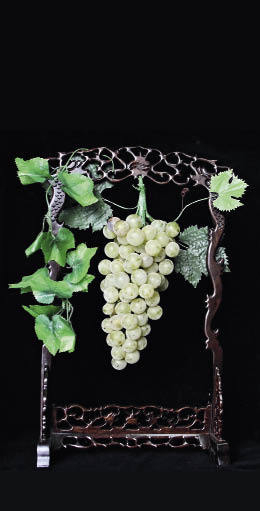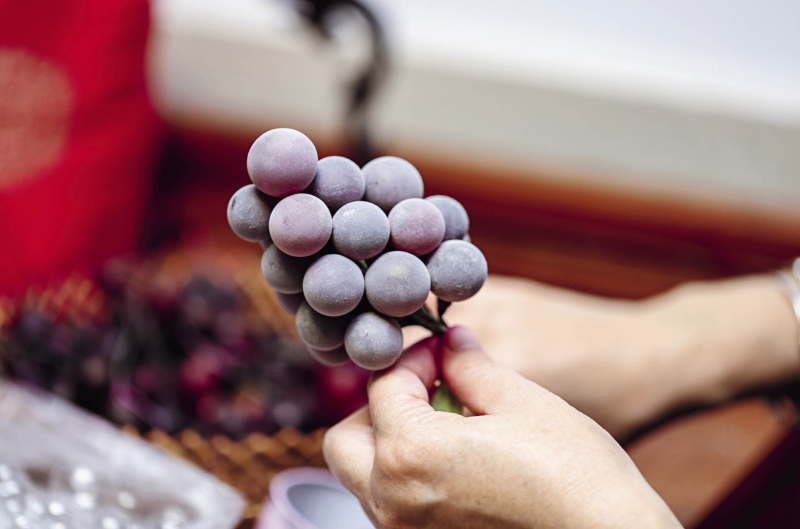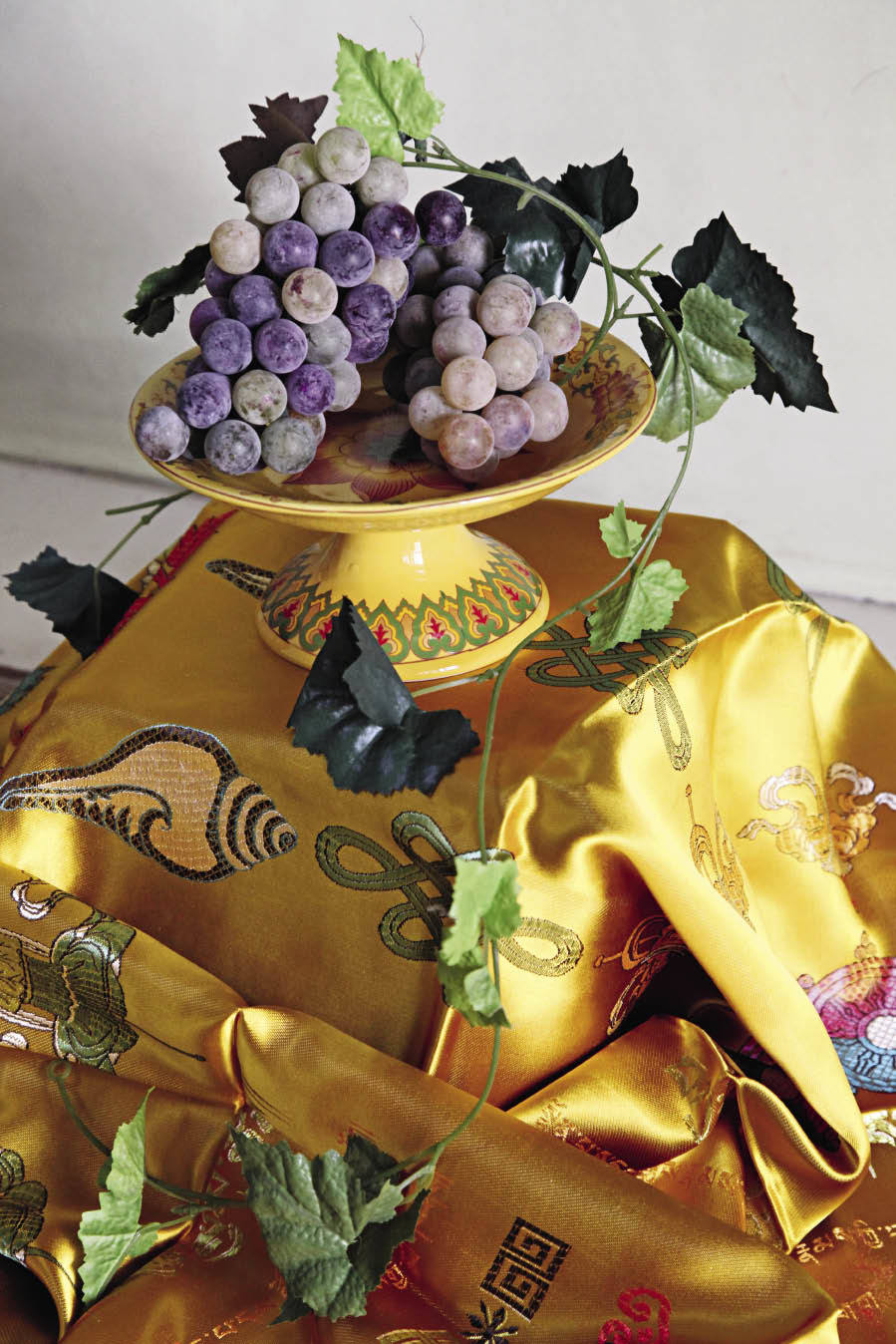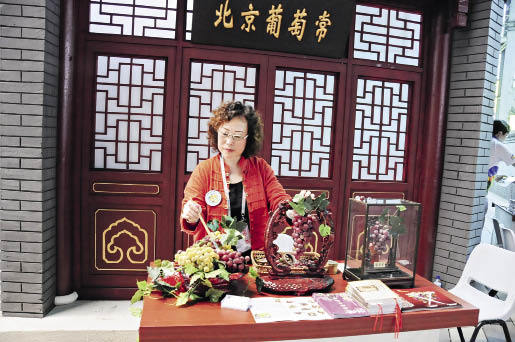
A trellis with crystal glistening Grape Chang grapes never fails to make people’s mouth water.
Chang Hong, the fifth-generation inheritor of Grape Chang, is familiar with the looks of disbelief from visitors. In many exhibitions she has observed almost everyone who sees the grapes wanting to touch or even taste them.
Grape Chang is a craft of making glass grapes, which first emerged during the reign of Emperor Guangxu (1875-1908) in the Qing Dynasty (1644-1911). Today, only Chang Hong and her sister Chang Yan know the formula and techniques of this ancient family heritage. In 2009, the craftsmanship of Grape Chang was included in the national intangible cultural heritage list, and it has been viewed and appreciated by many on various occasions since then.
Grape Craft History
Grape Chang is a brand for glass grapes, named after the family Chang, which has been renowned for their excellent craftsmanship in the field. Traditionally, the names of old Beijing folk arts are made up of the folk art and family name of the artisan, such as the Dough Figurine Lang and Clay Figurine Zhang, which is both catchy and simple.
Chang Hong’s ancestral name is not Chang; her ancestors were qiren (which literally means the banner people, who served in the military of Qing in different hierarchic segments based on their family lineage). In the Qing Dynasty, the banner people were supported by the royal family, which means many things even necessities such as sesame oil were distributed by the state. In addition, banner people were not allowed to be engaged in commerce. So they had lots of leisure time, which allowed them to develop many hobbies. Later, many of these people turned their hobbies and playthings into the means of making a living when their family began to decline.
Such is the case with the founder of Grape Chang, Hanqiharibu. He used to make various kinds of fruit out of clay for fun. When his family privilege was removed, he depended on the clay making skills to make a living. At the same time, he also tried to improve his craft and decided on a rare raw material at that time – glass.

It takes very complex techniques to make realistic-looking juicy grapes.
In 1894, Empress Dowager Cixi’s 60th birthday was celebrated at the Summer Palace in Beijing. When Cixi went to the palace theater to watch a play, a trellis with crystal glistening grapes hanging on it caught her attention. At that time, Beijing had entered early winter, so Cixi had a longing to eat fresh summery grapes. She therefore instructed her staff to pick some grapes for her to enjoy.
After a eunuch told her the grapes were not real, Cixi was very surprised and then found out that they were made by Hanqiharibu and his wife. As grapes had many pips, which implies many children and many blessings in Chinese, Cixi was pleased with this birthday gift and granted Hanqiharibu’s wife the title “Chang Zai” and gave her a plaque with the words Tian Yi Chang (meaning royal kindness always with you), to enable her to go home and open a business with the endorsement and support her family. In gratitude for the words of the empress, Hanqiharibu (the husband) changed his name to Chang Zai and his family changed their surname. Grape Chang subsequently became well known in Beijing.
Complex Techniques
The Grape Chang craft is very complicated. All processes rely heavily on manual skills. The birth of a bunch of grapes needs to go through more than 10 processes, and all the effort will be wasted if just a slightest mistake is made during one of them.
Generally, the production process of Grape Chang includes selection and melting of material, glass bead blowing, coloring, waxing, frosting, and assembly.
According to Chang Hong, selected glass is first melted into liquid, after which a very thin iron rod is used to pull out a glass pipe from the liquid. This pipe is then dipped into the glass liquid again and used to blow the liquid into hollow glass beads of grape size.
Blowing glass beads is the hardest step as it needs to be finished within seconds and the liquid glass has a temperature of more than 1,000 degrees Celsius. There is no mold to use during the whole process and the skill of the crafter is all that determines success.
After blowing the glass beads, it is time to make grape stalks. Cotton paper is rolled over thin wire and inserted into holes in the blown beads.
Next the beads are colored. Chang Hong said that the formula of color mixing is unique to her family. First, pigments are mixed into the color of grapes, and then heated after applying it onto the grapes. If the temperature is incorrect by just 10 to 20 degrees, the color will be different from that of the actual grapes. After coloring the beads, they are left to dry naturally.

A finished Grape Chang product is hard to distinguish from real grapes.
In addition, as colors on glass will make the glass reflective, the artisan needs to wax the glass beads to create the texture of grape skins. Waxing demands much patience and skill. After waxing, the grapes are air-dried. Next comes the final several steps including frosting, molding, and making leaves.
A major secret for Grape Chang’s vivid glass grapes lies in the layer of frost on the grapes, which makes people think they are freshly picked. This is another one of Chang’s craft stunts.
“We have a shrine for worshipping Buddha at home. We burn incense and worship Buddha every day. We give the grapes we make [as an offering],” said Chang Hong.
Chang Hong and her sister still remember an amusing incident about their glass grapes. One year at the Pantaogong temple fair in Beijing, they set up a grape trellis to decorate their exhibition area. There were a lot of visitors to the fair. Among them was a child, held in his parents’ arms, who insisted on eating the grapes and grabbed one with his hand. Chang Hong quickly informed the parents that the grapes were made of glass and if broken could hurt the child.
Inheritance and Expectations
One of the Chang family rules is that its craft is only passed on to female inheritors, which seems to be very different from what we know about family succession. Chang Hong explained that this is due to historical reasons, saying that in the old days most boys in banner families liked loafing about, while girls were usually more capable of learning practical skills. “Our family values girls more, because it’s the women who actually run the family,” said Chang Hong.

Chang Hong is at the Grape Chang exhibition table in the 2010 Expo in Shanghai.
Grape Chang has been handed down for five generations since its founding. The first four generations had all been engaged in the production of glass grapes. In fact the third generation vowed not to marry in order to keep the unique skills within the family.
However, when it came to the fifth generation, despite the prosperously growing family, no one wanted to inherit the skills. After the third generation inheritor Chang Yuling passed away in 1986, this ancestral craft was almost lost forever.
In 2003, a Beijing-based media outlet published an article reminiscing Grape Chang, lamenting the loss of a once flourishing folk art. After reading the article, the fifth generation of descendants, Chang Hong and her sister Chang Yan, were both deeply touched, and felt they needed to revive the family heritage.
“What I started to do was to compile information. My aunts were devoted to this craft all their lives, but they did not have the awareness or ability to record their craft methods. I used to go to the library and archives after work, look up all the information about old Beijing and put it together. Now almost all the written information about Grape Chang available online is compiled by me. I also have done a lot of work to introduce this craft to more people,” said Chang Hong.
Grape Chang is now rated as a national intangible cultural heritage project, and has therefore received some funding from the government. “My sister and I always say that we are a chain in terms of passing on our glass grape making skills,” said Chang Hong, adding that she is now teaching her granddaughter the craft, who is fortunately very interested in it.
“I also hope to further promote Grape Chang and increase its influence, thus attracting more people in our country to this intangible cultural heritage, which represents a part of our national soul,” said Chang Hong.